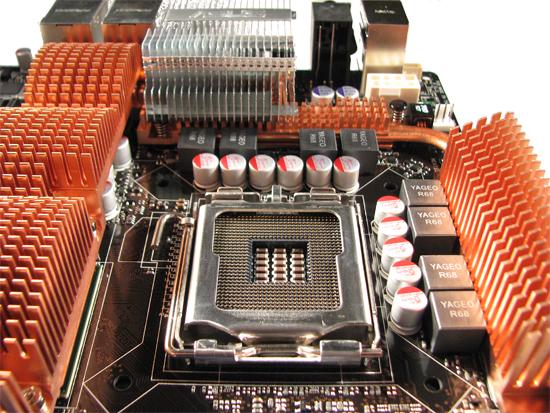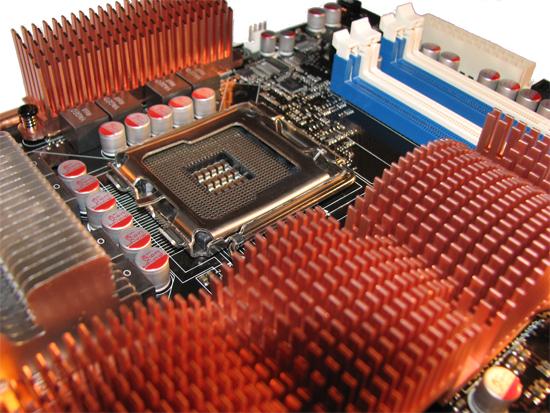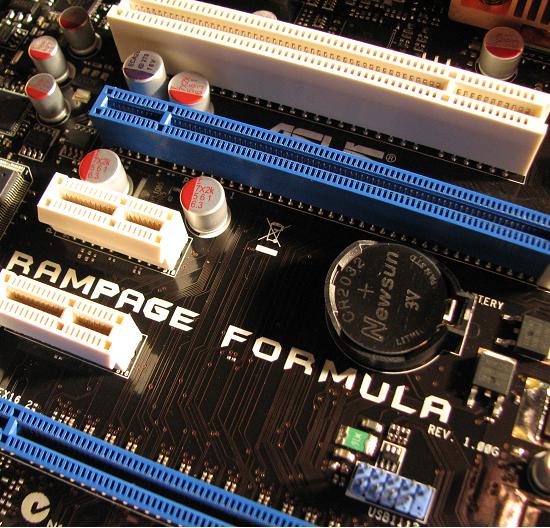ASUS ROG Rampage Formula: Why we were wrong about the Intel X48
by Kris Boughton on January 25, 2008 4:30 AM EST- Posted in
- Motherboards
Board Layout, Features and Specifications


The ASUS Rampage Formula makes use of a beefy 8-phase PWM solution. The copper heatsink covering the MOSFETS is actually not thermally coupled to the Northbridge or the Southbridge as the cooling solution consists of two separate blocks. The hold-down mechanism for the X48's high quality heatsink is comprised of four tension screws attached to a backplate on the opposite side of the board. Besides changing the thermal paste ASUS utilized, we feel there is nothing that needs modification by the end user as long as overclocking aspirations are within reason.


Two full x16 PCI-E 2.0 slots are available for official CrossFire support and the spacing is appropriate. We would have liked an additional PCI slot, for a total of three, instead of the three x1 PCI-E 1.x slots.
Six onboard SATA headers are on the right side of the board, each at 90 degree angles. This made inserting and removing cables easy, even with two full-length video cards installed.
One feature we particularly like is the volt-minder LEDs - one each for the CPU, Northbridge, Southbridge, and memory slots. Each can be one of three colors - green, yellow, or red - and they are useful for determining at a glance the approximate voltage being fed to each component. Green represents "safe" voltages, yellow is elevated (high), and red means "crazy high." Crazy high is just that too, as the board won't set the light red for the CPU voltage until it eclipses about 2.025V.
| ASUS R.O.G. Rampage Formula | |
| Market Segment | Gamer / Extreme Performance - $299.99 (estimated) |
| CPU Interface | Socket T (LGA-775) |
| CPU Support | LGA775-based Core2 Duo, Core2 Extreme, or Core2 Quad recommended, including next-generation 45nm compatibility (06/05B/05A processors) |
| Chipset | Intel X48 Northbridge (MCH) and ICH9R Southbridge |
| CPU Clock Multiplier | 6x ~ 11x, downward adjustable for Core2, upward to 31x for Extreme, half-multiplier support for 45nm processors |
| Front Side Bus Speeds | Auto, 200 ~ 800 in 1MHz increments |
| System Bus Speeds | 1600/1333/1066/800 (MHz) with Official DDR-1066 Support |
| DDR2 Memory Dividers | 1:1, 6:5, 5:4, 4:3, 3:2, 8:5, 5:3, and 2:1 (dependent upon strap setting) |
| FSB Strap | Auto, 200, 266, 333, 400 |
| PCIe Speeds | Auto, 100MHz ~ 180MHz |
| PCI Speeds | Locked at 33.33MHz |
| DRAM Voltage | Auto, 1.80V ~ 3.40V in 0.02V increments, 1.80V standard |
| DRAM CLK/CMD Skew CA/CB | Auto, Manual (Advance/Delay 50ps ~ 350ps in 50ps increments) |
| DRAM Timing Control | Auto, Manual - 20 DRAM Timing Options (tCL, tRCD, tRP, tRAS, tRFC + 15 sub-timings) |
| DRAM Command Rate | Auto, 1N, 2N |
| DRAM Static Read Control | Auto, Enabled, Disabled |
| Ai Clock Twister | Auto, Light, Moderate, Strong |
| Ai Transaction Booster | Auto, Manual |
| Common Performance Level | 1 ~ 31 (settings above 14 prevent POST) |
| CH A/B Phase Pull-In | Based on Memory Divider, All Phases Adjustable (Enabled/Disabled) |
| Core Voltage | Auto, 1.10000 to 1.60000 in 0.00625V increments then 0.05V increments |
| CPU PLL Voltage | Auto, 1.50 ~ 3.00v in 0.02V increments, 1.50V standard |
| FSB Termination Voltage | Auto, 1.20V to 2.00V in 0.02V increments, 1.20V standard |
| North Bridge Voltage | Auto, 1.25V ~ 1.85V in 0.02V increments, 1.25v standard |
| South Bridge Voltage | Auto, 1.050V ~ 1.225V in 0.025V increments, 1.050V standard |
| SB 1.5V Voltage | Auto, 1.50V ~ 2.05V in 0.05V increments, 1.50V standard |
| Loadline Calibration | Auto, Enabled, Disabled |
| CPU Voltage Reference | Auto, x0.63, x0.61, x0.59, x0.57 |
| NB Voltage Reference | Auto, x0.67, x0.63, x0.60, x0.57, x0.56, x0.53, x0.51, x0.49 |
| Memory Slots | Four 240-pin DDR2 DIMM Slots Dual-Channel Configuration Regular Unbuffered, non-ECC DDR2 Memory to 8GB Total |
| Expansion Slots | 2 - PCIe 2.0 x16, Supports ATI CrossFire
Technology 3 - PCIe (1.x) x1, (1) is Compatible with Add-in Audio Card 2 - PCI Slot 2.2 |
| Onboard SATA RAID | 6 SATA 3Gbps Ports - ICH9R (RAID 0, 1, 5, 10) |
| Onboard IDE (PATA) | JMicron JMB368 PATA Controller (up to two UDMA 133/100/66 devices) |
| Onboard USB 2.0/IEEE-1394 | 12 USB 2.0 Ports - (6) I/O Panel - (6) via
Headers 2 IEEE-1394(a) Ports - (1) I/O Panel, (1) via Header |
| Onboard LAN (with Teaming) | Realtek RTL8110SC - PCI Gigabit Ethernet
controller Marvell 88E8056 PCI Express Gigabit Ethernet controller |
| Onboard Audio | ADI 1988B - 8-channel HD Audio CODEC |
| Power Connectors | ATX 24-pin, 8-pin ATX 12V |
| I/O Panel | 1 x PS/2 Keyboard 2 x SPDIF - (1) Optical Out, (1) Coaxial Out 1 x IEEE-1394a 2 x RJ-45 (LAN) 6 x USB 2.0/1.1 1 Clear CMOS Switch |
| Fan Headers | 8 - (1) CPU, (1) Power, (3) Chassis, (3) Optional/Misc. |
| Fan Control | CPU and Chassis Fan Control via BIOS/Extreme Tweaker, PC Probe II monitoring |
| BIOS Revision | v0108 |
| Board Revision | 1.03G |
The ASUS Rampage Formula provides an impressive range of setting specifications. We would go so far as to say that more than a few of these are simply ridiculously high; however, there are sure to be a few people that require these options. A couple of the higher settings to pay attention to: CPU voltage well above 2.0V, CPU PLL voltage to 3.0V (sure to kill your chip super quick), FSB Termination voltage to around 2.0V, and DRAM voltages over 3.4V. While we certainly must commend ASUS on their fine range of control we also feel the need to strongly caution users when working with some of these settings. It's entirely possible to damage or destroy your chipset, CPU, or memory when moving to the extreme limits of these ranges; sometimes less is more.
As we have discussed before Loadline Calibration is best left disabled, especially when using the newer 45nm CPUs. Our testing has shown these settings induce power instabilities, even when using lower voltages. In addition, when enabled the option sometimes requires more CPU voltage than would otherwise be necessary, meaning increased power dissipation and higher temperatures.
Of note, the Rampage Formula allows for half-multiplier usage. This is particularly useful when working in the higher FSB ranges. Because all Core 2 Duo/Quad CPUs are downward unlocked, every half multiplier between the processor default value and 6 can be used, with the exception of 6.5x. For the Extreme processors, this limitation has been relaxed allowing for multipliers as high as 31x in half steps. Besides providing finer CPU frequency control, half-multipliers permit a wider choice of final multiplier/FSB combinations, which can help when choosing the best operating point for the processor and memory. Now that we have experienced what these new values have to offer, it will be hard to work with anything else.
As we pointed out before, "Ai Transaction Booster" is completely revamped for this board series. Setting this option to manual allows the user to take full control of the "Common Performance Level", meaning that all memory phases will baseline at the value as set. Each individual phase can then be "pulled-in" or left as is. "Pulling-in" a phase reduces just that phase's associated tRD value (performance level) by one. Like memory timings, lower values are tighter and thus provide better memory read performance and lower latencies. If all phases are pulled-in, this is the equivalent of selecting the next lower common performance level and performs identically to this new setting. Thus, pulling-in particular phases can allow the user to affect a minor performance improvement if selecting the next lower common performance level is not possible.










73 Comments
View All Comments
dallas - Monday, March 24, 2008 - link
I was wondering how this chipset and Windows Vista 64-bit handles IRQ ? I have a Creative X-fi and it has had a lot of problems with PCI-latency and shared IRQ. According to the manual PCI slot 2 is the only one of the two that does not share IRQ with the graphic cards. Do you guys have any experience of this ?Second question is related also to IRQ. I have a Razer Deathadder mouse which I use at 1000Hz polling rate and it seems to cause quite a bit CPU-usage (average of 10% with AMD64 3500+ when moving mouse at desktop without overlapping anything). I guess it would be ideal to connect it to a USB-port not sharing any IRQ. Rampage Formula has 12 USB-ports total, but reading the manual it says there is USB controllers 1 to 6 and USB 2.0 controllers 1 and 2. How do I relate these figures to the actual layout of the board ? USB controllers 2 and 5 are the only ones not sharing IRQ.
http://dlsvr01.asus.com/pub/ASUS/mb/socket775/Ramp...">http://dlsvr01.asus.com/pub/ASUS/mb/soc...rmula/Ra...
Thanks
nitemareglitch - Friday, March 7, 2008 - link
My older DFI nForce 4 board had fully adjustable tRd among other things. Asus taking a play from their book?rge - Monday, February 18, 2008 - link
Granted I am using gigabyte p35 dq6 board, but I thought loadline simply was a sensor adjustment? Anyone know what is meant by induced power instabilities? measured by?I thought (and may well be wrong) that with loadline disabled, if I choose 1.25v bios as vcore, idle would be 1.23 volts (Voffset), load (dual core) would be 1.22v (Vdroop), when load stops, overshoot to 1.25v before decreasing back to 1.23 idle. Thus when you are choosing 1.25 volts in bios, you are choosing max volts ie, overshoot max, and not idle volts.
I thought loadline was simply a ~.02v sensor calibration, so when enabled, and you choose 1.25 volts in bios, you are then choosing the idle volts (instead of overshoot max) and thus it idles at 1.25V. During load you still see vdroop to 1.24v, and overshoots to 1.27v.
In other words no difference between loadline enabled 1.23v and loadline disabled 1.25v, just personal preference of making bios vcore set idle volts or max overshoot volts.
If I am wrong can someone please inform me what loadline is, and what is meant by power instabilities...mean ?greater fluctuations in volts or what?
Nickel020 - Saturday, February 16, 2008 - link
Firstly, great article! Got me a long way in increasing my memory speed and understanding the underlying factors.What I don't understand though is why the X48 is better than the X38. I already have the option to change tRD on my Gigabyte P35 DQ6, and I'm getting much better memory perfromance after manually setting it to 6.
As I see it, the option to adjust tRD is only a BIOS issue and it can be done on P35 and X38, so how does this make the X48 a better chipset?
kjboughton - Sunday, February 17, 2008 - link
The difference comes in the voltages required to run equivalent speeds/tRD settings. In fact, the X48 board are capable of running stable at much higher speeds, using tigher MCH Read Delay (tRD) values at lower voltages. More to come soon...Holmer - Monday, February 18, 2008 - link
Thanks for an excellent article.I would just love to know how well the Rampage formula handles overclocking with 4x1 GB RAM? How large is the performance hit as compared to 2x2 GB and can it handle 1200 MHz (with two 2x1 GB kits rated at this speed).
Roughly when can we expect the loon awaited X48 roundup?
Thanks a lot on beforehand.
Holmer - Friday, February 22, 2008 - link
Another question: Is is possible to manually set tRFC > 42 in BIOS? If yes what is the maximun value of tRFC?I would be very grateful for an answer.
The Ghost - Saturday, February 2, 2008 - link
With 400Mhz, tRD of 4, CL of 4 and 3:2 ratio I get this:1,334 > 1,333
Is that enough to post or is 0,001 to little to "allowed" ?
Vikendios - Wednesday, January 30, 2008 - link
It's all very fine, but as long as ATI/AMD GPU's are outclassed by Nvidia's, the gamer scene which drives the $300+ motherboard business has little interest in non-Nvidia-SLI solutions. It's bizarre that Intel focuses on chipsets that can apparently only handle well (correct me if I'm wrong) their arch-competitors AMD's GPU's in (Crossfire) arrays.Intel should hurry to develop competitors to 790i that are really neutral as to which twinned or tripled video cards are used.
Gary Key - Wednesday, January 30, 2008 - link
The last time I tested it, X38 ran SLI faster than 680i. The problem is not the chipset, it is simply a decision by NVIDIA (and/or Intel) not to "officially" license SLI on the Intel chipset platforms, except for the upcoming Skulltrail board.This whole SLI/Crossfire debate has gone on long enough, the technologies accomplish the same purpose (are practically identical from a technological viewpoint) and setting up a board/BIOS to run either is actually very easy. CF runs just fine on the NV680i/780i and SLI runs just fine on the 975X/X38/X48 if driver support is present and the proper switches are enabled in the BIOS. Personally, I would like to have the ability to run (unhindered) AMD or NVIDIA GPUs in multi-GPU configurations on either chipset platform. I just wish they would let the market determine the best multi-GPU solution, but that is pie in the sky thinking. ;)